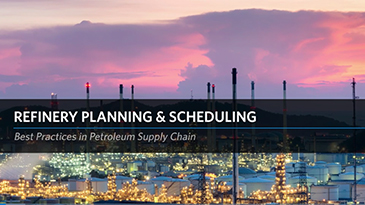Although it may seem like old news, the International Maritime Organization’s (IMO) 2020 regulations are looming, and if you haven’t taken the time to establish your business’s plan and response, they will have a huge impact on refinery economics. (If you are not familiar with IMO 2020, here’s a quick introduction to the regulations and a summary of the health and environmental impacts.)
There are myriad implications for marine shippers, but let’s focus on the refining implications. There will be a huge shift in global refined product demand. This means price spikes for low-sulfur fuel oil (LSFO) and price craters for high sulfur fuel oil (HSFO). For refinery planners, this means a terrific opportunity to make money for the company.
Thinking about this problem as an “asset optimization” problem will help your planning team collaborate with your business team. Although it may be too late to appropriately scope large projects, you can still squeeze in small ones and align budgets when the new regulations are implemented in 2020, as well as through market adaptations in 2021 and beyond.
For example, multi-year-term contracts for low-sulfur crudes may be more advantageous, and distillate prices will shift relative to HSFO. You can also use your refinery planning model (typically called an LP or linear program) to test the new LSFO specs to see what new constraints will limit your refinery, and then collaborate with technical teams to brainstorm projects to bust those constraints.
The IMO 2020 regulations will be a boon for some refiners, especially those with extensive vacuum resid processing capacity (i.e., coking, visbreaking, hydrocracking). If rates have been reduced for some time, you may consider preparatory high-rates proof-testing. Identifying problems and constraints now would enable you to put the necessary projects in place well before the 2020 implementation date.
The take-home message is the IMO 2020 regulation will be an opportunity for some refiners, but for others it will be a significant challenge. In either case, there are a number of approaches you should consider to improve your position and ensure overall competitiveness in the period between 2020 and 2024 when a new equilibrium is found. The more effective approaches are technology-enabled, but all come back to a focus on enabling your workforce to adapt to new operational realities posed by IMO 2020. For example:
-
Enhance your refinery planning capability. Improve refinery planning model accuracy, solution robustness, contingency planning and speed in order to better capitalize on market opportunities and evaluate operational and small capital opportunities. (This may require an of upgrade of your LP.)
-
Improve your dynamic operational management capability. Optimize yield and energy performance to maximize overall margins. The focus should be on improving operator capabilities and leveraging new, Adaptive Process Control technology with a user interface that allows for rapid adjustments to controller focus
-
Integrate predictive capabilities. Leverage new predictive analytics to make unplanned downtime a thing of the past by predicting future asset behavior, optimizing production plans accordingly and/or performing prescriptive maintenance to reduce or eliminate that unplanned downtime.
If you have any questions or comments, you can reach out to me via email or on LinkedIn. In conclusion, here is a table summarizing recommended actions, as well as some further reading below.
|
|
Time Frame |
||
|
Focus Area |
Long Term (Now) |
Medium Term (2019) |
Short Term (2020) |
|
Contracting and Procurement |
|
|
|
|
CAPEX Projects |
|
|
|
|
Feed and Product Optimization |
|
|
|
|
Improve Operational Management Capabilities through New Technology |
|
|
|
Recommended Reading
- IMO’s “The 2020 Global Sulfur Limit: FAQ”
- Shell’s recent white paper “IMO 2020: What’s Next?”
-
IHS Markit: “Refining and Shipping Industries Will Scramble to Meet the 2020 IMO Bunker Fuel Rules”
-
ExxonMobil’s guidance for switching to low-sulfur fuel (to share with your marine organization/3PL)






Leave A Comment